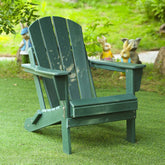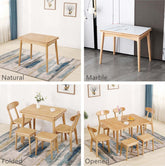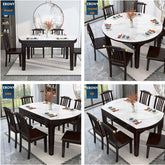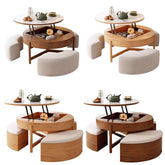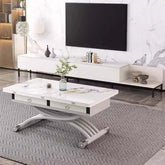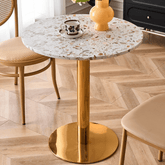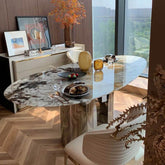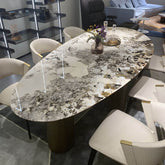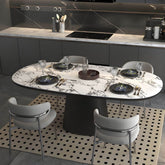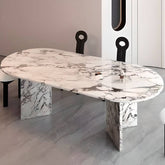How to Clean Marble Tables: The Ultimate Guide to Maintaining Elegance

Marble, with its intricate veining and luminous surface, has long been a symbol of luxury and sophistication in homes and commercial spaces alike. From grand countertops to elegant dining tables, its natural beauty adds an undeniable touch of class. However, this exquisite material, while durable in many respects, is also notoriously delicate and susceptible to damage from spills, scratches, and improper cleaning methods. Its porous nature and sensitivity to acidic substances mean that a casual wipe-down with just any cleaner can lead to irreversible etching or dulling of its pristine finish.
This comprehensive guide is designed to demystify the process of cleaning and maintaining your marble table, ensuring its longevity and preserving its inherent elegance. Whether you're a new marble owner or have been enjoying its beauty for years, you'll find practical, SEO-friendly advice, actionable steps, and expert tips to keep your marble looking its best. We'll delve into everything from daily care routines to tackling stubborn stains, and crucially, what products to avoid at all costs. By understanding the unique characteristics of marble and adopting the right cleaning techniques, you can confidently protect your investment and continue to enjoy the timeless allure of your marble table. This article will specifically focus on how to clean marble table surfaces effectively and safely.
Understanding Marble: Why Special Care is Needed
To truly appreciate why marble requires such specific care, it’s essential to understand its fundamental characteristics. Unlike engineered stones or ceramics, marble is a natural metamorphic rock, primarily composed of recrystallized carbonate minerals, most commonly calcite or dolomite. These minerals give marble its distinctive appearance but also contribute to its unique vulnerabilities.
Porous Nature: The Hidden Sponges
One of marble’s most significant characteristics is its porosity. While its surface may appear solid and impenetrable, marble is riddled with microscopic pores and capillaries. These tiny channels act like sponges, readily absorbing liquids that come into contact with the surface. This is why spills, especially those from colored liquids like red wine, coffee, or fruit juice, can quickly penetrate the stone and leave deep, difficult-to-remove stains. The longer a liquid sits on unsealed or poorly sealed marble, the deeper it can seep, making stain removal a challenging task.
Acid Sensitivity: The Etching Enemy
Perhaps marble’s most well-known Achilles’ heel is its extreme sensitivity to acids. Calcite, the primary component of most marble, reacts chemically with acidic substances. This reaction, known as etching, dissolves a tiny layer of the marble surface, resulting in dull spots, lightened areas, or even rough patches. Common household items that are acidic and can cause etching include:
- Vinegar
- Lemon juice and other citrus fruits
- Tomato products
- Alcoholic beverages (especially wine)
- Many common household cleaners (e.g., bathroom cleaners, glass cleaners)
Even seemingly innocuous substances like carbonated drinks or certain foods can cause etching if left on the surface. Unlike stains, which involve a foreign substance penetrating the stone, etching is a physical alteration of the marble itself, making it much harder to repair without professional intervention.
Sealing: Your Marble’s First Line of Defense
Given its porous and acid-sensitive nature, sealing marble is not just recommended but essential. A penetrating sealer works by filling the microscopic pores just below the surface of the marble, creating a barrier that slows down the absorption of liquids. It doesn’t make the marble stain-proof or etch-proof, but it provides a crucial window of time for you to wipe up spills before they can cause permanent damage. Think of it as a protective layer that buys you time. Regular reapplication of a high-quality marble sealer is vital for maintaining this protection, with frequency depending on the marble’s usage and the type of sealer used.
Understanding these inherent properties of marble—its porosity, acid sensitivity, and the protective role of sealing—is the foundation for effective cleaning and long-term care. It explains why a gentle, proactive approach is always the best strategy for preserving the beauty and integrity of your marble table.
Everyday Cleaning: Keeping Your Marble Pristine

Maintaining the pristine appearance of your marble table doesn't require complex procedures or harsh chemicals. In fact, the key to everyday cleaning lies in simplicity, consistency, and gentleness. Regular, mindful cleaning habits can prevent the buildup of dirt and grime, significantly reducing the need for more intensive stain removal later on.
Daily Dusting: The First Line of Defense
The simplest yet most crucial step in daily marble care is regular dusting. Dust, crumbs, and other dry debris can accumulate on the surface, and if left unchecked, can scratch the delicate marble when wiped or moved. Use a soft, clean, and dry microfiber cloth to gently wipe down your marble table daily, or as often as needed. Avoid using abrasive sponges or cloths that could potentially scratch the surface. This quick routine prevents surface grit from becoming embedded or causing micro-scratches over time.
Gentle Cleaning Solution: The Mild Approach
For general cleaning and to remove light spills or smudges, a mild, pH-neutral cleaning solution is all you need. The best and safest option is a mixture of mild dish soap and warm water. Here’s how to prepare and use it:
- Prepare the Solution : Fill a spray bottle or a small bowl with warm water. Add just a few drops of a mild, non-abrasive dish soap (e.g., Dawn, Palmolive). You want a very dilute solution – too much soap can leave a residue or streak.
- Apply Gently : Dampen a clean, soft microfiber cloth with the solution. Wring out any excess water thoroughly; the cloth should be damp, not soaking wet. Excess water can leave water spots or seep into the marble’s pores.
- Wipe the Surface : Gently wipe down the entire marble surface. For slightly more stubborn spots, you can apply a little more pressure, but avoid scrubbing vigorously.
Wiping and Drying: Avoiding Water Spots and Streaks
After cleaning with the soapy water solution, it’s critical to rinse and dry the marble thoroughly to prevent water spots, streaks, or soap residue buildup. This two-step process ensures a spotless, gleaming finish:
- Rinse : Dampen a second clean microfiber cloth with plain warm water (no soap). Wipe down the entire marble surface again to remove any soap residue. This step is often overlooked but is vital for a streak-free shine.
- Dry : Immediately follow with a third clean, dry microfiber cloth. Buff the marble surface until it is completely dry and shiny. Allowing marble to air dry can lead to unsightly water spots, especially in areas with hard water. Ensure no moisture is left behind, as standing water can also contribute to etching or staining over time.
By consistently following these simple everyday cleaning practices, you can keep your marble table looking its best, preserving its natural beauty and elegance for years to come. Remember, gentleness and promptness are your best allies in marble care.
Tackling Common Stains: A Spot-Cleaning Guide

Despite diligent everyday cleaning and preventative measures, accidents happen, and marble tables can still fall victim to various stains. The key to successful stain removal on marble is prompt action and using the correct method for the specific type of stain. Remember, marble is delicate, so always start with the least aggressive method and work your way up.
Food and Drink Stains (Organic Stains)
These are typically caused by coffee, tea, wine, fruit juices, food coloring, and other organic materials. They often leave a pinkish-brown stain.
-
Immediate Action : For fresh spills, blot (do not wipe) the liquid immediately with a clean, soft cloth or paper towel. The quicker you act, the less likely the liquid is to penetrate the marble’s pores.
-
For Stubborn Stains – The Poultice Method : A poultice is a soft, paste-like material that is applied to the stain, allowed to dry, and then removed. As it dries, it draws the stain out of the marble. For organic stains, a simple poultice can be made with baking soda and hydrogen peroxide.
How to Make and Apply a Baking Soda & Hydrogen Peroxide Poultice:
- Mix : In a non-metal bowl, mix baking soda with 3% hydrogen peroxide to form a thick, peanut butter-like paste. For very dark stains, you can add a few drops of ammonia (but never mix ammonia with bleach!).
- Apply : Apply a thick layer (about 1/4 to 1/2 inch thick) of the paste directly over the stain, extending slightly beyond its edges.
- Cover : Cover the poultice with plastic wrap and tape down the edges to prevent it from drying out too quickly. This keeps the poultice active for longer.
- Wait : Allow the poultice to sit for at least 24 to 48 hours, or until it is completely dry. As it dries, it will pull the stain from the marble.
- Remove : Once dry, gently scrape off the hardened poultice with a plastic scraper or wooden spatula. Rinse the area with distilled water and dry thoroughly with a clean cloth.
- Repeat : For very stubborn stains, you may need to repeat the process multiple times.
Oil-Based Stains
These stains result from grease, cooking oil, hand lotion, cosmetics, and other oily substances. They typically appear as dark spots that darken the stone.
-
For Oil-Based Stains – The Cornstarch/Talc Poultice : Similar to organic stains, a poultice is effective, but the absorbent material differs.
How to Make and Apply a Cornstarch/Talc Poultice:
- Mix : Create a paste by mixing cornstarch, talcum powder, or fuller’s earth with a solvent like acetone (nail polish remover) or mineral spirits. The consistency should be like thick peanut butter.
- Apply, Cover, Wait, and Remove : Follow the same application, covering, waiting, and removal steps as described for the baking soda and hydrogen peroxide poultice. The solvent helps to break down the oil, and the powder absorbs it.
- Clean : After removing the poultice, clean the area with mild dish soap and water, then rinse and dry.
Water Spots / Hard Water Stains
These are often caused by standing water that evaporates, leaving behind mineral deposits. They appear as dull, whitish rings or spots.
-
Buffing : For minor water spots, sometimes gentle buffing with a dry, soft microfiber cloth can remove them.
-
Fine Steel Wool (Use with Extreme Caution!) : For more persistent water spots, some experts suggest very carefully buffing the area with 0000 grade (super fine) steel wool. This should only be done on honed (matte) marble, and with extreme caution, as it can scratch polished marble. Always test in an inconspicuous area first. Apply minimal pressure and buff in small circular motions.
-
Specialized Marble Cleaners : There are commercial marble cleaners specifically designed to address water spots and light etching. Always choose a pH-neutral product formulated for marble and follow the manufacturer’s instructions precisely.
-
Professional Help : For severe or widespread water spots, or if you are unsure, it’s always best to consult a professional stone restorer.
Remember, patience is key when dealing with marble stains. Avoid using harsh chemicals or abrasive scrubbers, as these can cause more damage than the stain itself. If in doubt, seek professional advice.
Preventative Measures: Protecting Your Investment

While knowing how to clean marble is essential, the best approach to maintaining its beauty is through proactive prevention. By implementing a few simple habits and taking thoughtful precautions, you can significantly reduce the likelihood of stains, etching, and other damage, ensuring your marble table remains a stunning centerpiece for years to come. Think of these measures as an investment in your marble’s longevity and pristine appearance.
Coasters and Trivets: Your Marble’s Best Friends
This is perhaps the most fundamental and effective preventative measure. Always use coasters under glasses, cups, and bottles, especially for beverages that are acidic (like soda, juice, or wine) or very hot/cold. Condensation from cold drinks can leave water rings, and heat from hot items can cause thermal shock or discoloration. Similarly, use trivets or hot pads under hot dishes, pots, and pans. Even if you think an item isn’t hot enough to cause damage, it’s always better to be safe than sorry. This simple habit creates a barrier between potential threats and your marble surface.
Spill Management: Act Fast, Act Smart
Given marble’s porous nature, prompt spill management is critical. Any liquid, especially acidic ones, can quickly seep into the stone and cause etching or staining if left unattended. Develop the habit of wiping up spills immediately. Keep a soft, absorbent cloth handy near your marble table for quick clean-ups. Blot the spill rather than wiping or rubbing, as rubbing can spread the liquid and push it deeper into the pores. The faster you respond, the higher the chance of preventing permanent damage.
Regular Sealing: A Crucial Barrier
As discussed earlier, sealing is vital for marble. Regular reapplication of a high-quality penetrating sealer creates an invisible barrier that significantly slows down the absorption of liquids. The frequency of sealing depends on several factors:
- Usage : High-traffic tables (e.g., dining tables) may need more frequent sealing than decorative side tables.
- Type of Marble : More porous marbles might require more frequent sealing.
- Type of Sealer : Some sealers offer longer-lasting protection than others.
As a general guideline, many experts recommend sealing marble tables every 6 to 12 months, but it’s best to test your marble’s absorbency periodically. To do this, place a few drops of water on the surface. If the water beads up, your sealer is still effective. If it starts to soak in within a few minutes, it’s time to re-seal. Always follow the manufacturer’s instructions for the specific sealer you choose.
Placement: Mind Your Environment
The location of your marble table can also impact its longevity. Avoid placing marble tables in direct sunlight for extended periods, as prolonged exposure can cause discoloration or fading over time. Similarly, keep marble away from direct heat sources like radiators, fireplaces, or heating vents, as extreme temperature fluctuations can stress the stone. While marble is durable, a stable environment contributes to its long-term preservation.
By incorporating these preventative measures into your routine, you’re not just cleaning your marble table; you’re actively protecting your investment and ensuring its enduring beauty for generations to come. A little prevention goes a long way in marble care.
Products to Avoid: What Never to Use on Marble
While the temptation to use readily available household cleaners on your marble table might be strong, it’s crucial to understand that many common cleaning products are highly detrimental to marble. Using the wrong product can cause irreversible damage, leading to etching, discoloration, or dulling of the surface. To protect your marble, commit this list to memory and keep these substances far away from your elegant stone.
Acidic Cleaners: The Marble’s Arch-Nemesis
As previously discussed, marble is primarily composed of calcium carbonate, which reacts violently with acids. This reaction causes etching, a dull spot or mark where the acid has literally eaten away at the stone’s surface. Once etched, the only way to restore the marble’s shine is through professional re-polishing or honing. Therefore, never use any acidic cleaners on marble. This includes, but is not limited to:
- Vinegar : A popular natural cleaner, but its acetic acid content makes it highly corrosive to marble.
- Lemon Juice and other Citrus-based Cleaners : Citric acid in these products will etch marble.
- Ammonia-based Cleaners : While not an acid, ammonia is highly alkaline and can also dull marble’s finish over time and strip sealants.
- Bathroom Cleaners : Most bathroom cleaners are formulated to tackle soap scum and hard water stains, often containing strong acids or harsh chemicals that will severely damage marble.
- Grout Cleaners : These are typically very acidic and designed for ceramic tiles, not natural stone.
Abrasive Cleaners: Scratching the Surface
Marble’s polished surface is susceptible to scratching. Using abrasive cleaners or tools will inevitably lead to micro-scratches and dullness, diminishing its reflective quality. Avoid all abrasive cleaners and tools, such as:
- Scouring Powders or Creams : These contain fine abrasive particles that will scratch the marble surface.
- Abrasive Sponges or Scrub Pads : Even seemingly soft scrub pads can be too harsh for marble.
- Steel Wool (except 0000 grade for specific water spots, with extreme caution) : Regular steel wool will scratch and dull the surface. Only the finest grade (0000) should be considered for specific, targeted water spot removal on honed marble, and always with extreme care and prior testing.
Harsh Chemicals and All-Purpose Cleaners
Many general-purpose household cleaners contain chemicals that are too strong or have an unsuitable pH for marble. These can strip away sealants, leave residues, or cause discoloration. Steer clear of :
- Bleach : While sometimes recommended for certain stains, bleach can strip sealants and, if left on too long, can cause discoloration or weaken the stone.
- Generic All-Purpose Cleaners : Unless explicitly stated as safe for natural stone or marble, assume they are not. Their chemical composition is often too aggressive.
- Window Cleaners : Many contain ammonia or other chemicals that are not suitable for marble.
In summary, when it comes to cleaning your marble table, less is truly more. Stick to the mildest, pH-neutral solutions like diluted dish soap and water, and always prioritize gentle cleaning methods. When in doubt, if a product doesn’t specifically state it’s safe for marble or natural stone, do not use it.
Frequently Asked Questions (FAQs)
Here are some common questions marble table owners often have, along with expert answers to help you maintain your beautiful stone.
Can I use vinegar to clean marble?
Absolutely NOT. Vinegar is highly acidic (containing acetic acid) and will react with the calcium carbonate in marble, causing etching. Etching appears as dull spots or marks where the marble’s surface has been corroded. While it might seem like a natural cleaning solution, it is one of the worst things you can use on marble. Stick to mild, pH-neutral cleaners like diluted dish soap and water.
How often should I seal my marble table?
The frequency of sealing depends on the type of marble, its usage, and the specific sealer product. As a general guideline, most experts recommend sealing marble tables every 6 to 12 months. However, it’s best to perform a water test periodically: place a few drops of water on the surface. If the water beads up, your sealer is still effective. If it starts to soak into the stone within a few minutes, it’s time to re-seal. Always follow the manufacturer’s instructions for your chosen sealer.
What is the best cleaner for marble?
The best everyday cleaner for marble is a simple solution of mild, pH-neutral dish soap and warm water. For specialized cleaning or stubborn stains, there are commercial marble cleaners available that are specifically formulated to be safe for natural stone. Always ensure any product you use is labeled as safe for marble or natural stone and avoid anything acidic or abrasive.
How do I remove etch marks from marble?
Removing etch marks is more challenging than removing stains because etching is a physical alteration of the marble surface, not just a discoloration. For light etch marks, you might be able to use a marble polishing powder or a specialized etch remover kit, following the product instructions carefully. However, for deeper or widespread etch marks, professional help is usually required. A stone restoration specialist can re-hone or re-polish the marble to restore its original finish. Attempting to fix severe etching yourself without proper knowledge and tools can lead to further damage.
Conclusion
Your marble table is more than just a piece of furniture; it’s an investment in timeless elegance and a testament to natural beauty. While its delicate nature demands a thoughtful approach to care, maintaining its pristine condition is entirely achievable with the right knowledge and consistent habits. The essence of marble care boils down to gentleness, promptness, and prevention.
We’ve explored the fundamental reasons why marble requires special attention—its porous structure and extreme sensitivity to acids. We’ve also outlined the simple yet effective strategies for everyday cleaning, emphasizing the use of mild, pH-neutral solutions and the importance of thorough drying. For those inevitable spills and stains, we’ve provided practical guidance on tackling common issues with appropriate poultice methods, always advocating for patience and caution.
Crucially, we’ve highlighted the power of preventative measures: the non-negotiable use of coasters and trivets, the immediate response to spills, and the vital role of regular sealing. Equally important is knowing what to avoid—acidic cleaners, abrasive materials, and harsh chemicals that can inflict irreversible damage.
By embracing these practices, you’re not just cleaning your marble table; you’re actively preserving its inherent charm and ensuring its longevity. With a little care and attention, your marble table will continue to be a stunning focal point in your home, radiating sophistication and beauty for many years to come. Try these expert tips today and keep your marble looking its absolute best!
References
- Marble Institute of America (MIA) - Care & Cleaning of Natural Stone : A comprehensive guide developed by the Marble Institute of America providing routine cleaning guidelines and stain removal procedures for natural stone.
- Natural Stone Institute - Consumers : The industry's leading association offering information on natural stone, from stain removal to accredited stone companies.
- Martha Stewart - How to Clean Marble Surfaces the Right Way : Provides practical advice on cleaning marble surfaces, emphasizing mild detergents and warm water.
- GSA - Methods Of Cleaning Dirt On Marble : Guidance on cleaning honed and polished marble surfaces using various methods.
- Olson Cleaning - Diagnosing Common Marble Issues : Highlights the importance of using pH-neutral, stone-safe cleaners for marble.
- The Tile Shop - How To Clean Marble Tile Like a Pro : Offers tips on cleaning marble tile, advising against acidic or abrasive cleaners.
- Aalto Marble Inlay - Essential Care and Maintenance Tips for Marble Surfaces : Provides essential care and maintenance tips for marble surfaces.
- Jen McFadyen - How to Care for Marble Countertops : Discusses the frequency of sealing marble countertops.
- Marble.com - How to Care for Marble Surfaces : Explains how marble can stain and its sensitivity to acids.
